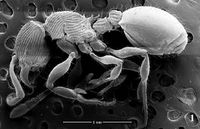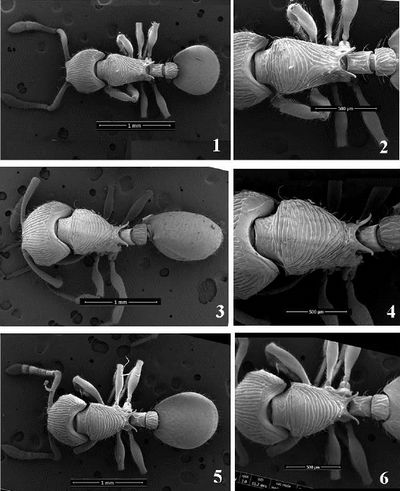Myrmecina urbanii
| Myrmecina urbanii | |
|---|---|

| |
| Scientific classification | |
| Kingdom: | Animalia |
| Phylum: | Arthropoda |
| Class: | Insecta |
| Order: | Hymenoptera |
| Family: | Formicidae |
| Subfamily: | Myrmicinae |
| Tribe: | Crematogastrini |
| Genus: | Myrmecina |
| Species: | M. urbanii |
| Binomial name | |
| Myrmecina urbanii Tiwari, 1994 | |
Nests in leaf litter. It forages individually and has the ability to hide swiftly within the litter.
Photo Gallery
Identification
Tiwari (1994) - This species is similar to Myrmecina striata in having colour pattern of the body, pilosity and pubescence, placement of the eye, scape reaching up to the top of the head; but it differs with the same in having following characters: transverse striations on alitrunk, 'Y’-shaped striation on meso- and metanotum, mesonotum armed with a pair of small acute spines and bead longer than broad.
Verghese (2018) - In addition to characters specified by Tiwari (1994), M. urbanii workers are characterized by: antennae 12 segmented with 3 segmented club; basal funicular segments broader than long, apical 3 segments much longer than other segments. Small teeth on antero-lateral corners of pronotum and metanotum; propodeal spines long, thick and curved upwards; petiole longer than broad with a distinct subpetiolar process.
Keys including this Species
Distribution
Distribution based on Regional Taxon Lists
Oriental Region: India (type locality).
Distribution based on AntMaps
Distribution based on AntWeb specimens
Check data from AntWeb
Countries Occupied
| Number of countries occupied by this species based on AntWiki Regional Taxon Lists. In general, fewer countries occupied indicates a narrower range, while more countries indicates a more widespread species. |

|
Estimated Abundance
| Relative abundance based on number of AntMaps records per species (this species within the purple bar). Fewer records (to the left) indicates a less abundant/encountered species while more records (to the right) indicates more abundant/encountered species. |

|
Biology
Castes
Worker
 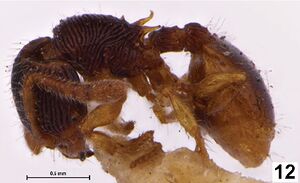    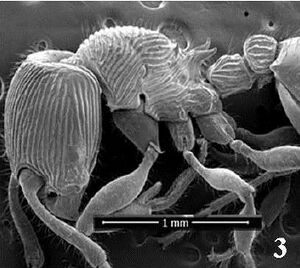 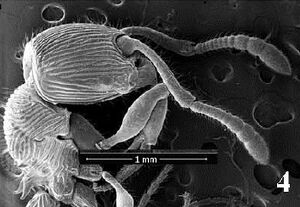 
| |
| . | |
Verghese et al. 2018. Plate 3. Figures 1-6. M. urbanii workers of different sizes: 1. & 2. Small worker, dorsal view. 3. & 4. Medium size worker, dorsal view. 5. & 6. Larger worker, dorsal view.
Queen
Verghese et al. 2018. Plate 1. Figures 1-4. M. urbanii, dealate: 1. Profile of M. urbanii; 2. Dorsal view of M. urbanii; 3. & 4. Mesosoma, profile and dorsal view of M. urbanii.
Nomenclature
The following information is derived from Barry Bolton's Online Catalogue of the Ants of the World.
- urbanii. Myrmecina urbanii Tiwari, 1994: 152, fig. 1 a-d (w.) INDIA.
Unless otherwise noted the text for the remainder of this section is reported from the publication that includes the original description.
Description
Worker
Head and alitrunk dark reddish-brown; antennae and pedicel paler; legs brownish yellow; abdomen dark brown, laterally and apically brownish yellow. Body fairly densely hairy; mandibles fairly hairy; clypeus with a few long anteriorly directed hairs.
Head capsule sub-squarish, deeply emarginate at posterior margin; postero-lateral angles rounded; dorsal surface longitudinally striated, sides weakly convex. Clypeus bicarinate and tridentate, carinae fused,with postero-lateral ridges. Eyes small (0·05 mm in diameter), round to oval, situated antero-laterally in front of middle of head and surrounded by paler area. Mandibles smooth, hairy; masticatory margins with three teeth, molar plate with a number of round crenulations. Antennae 12-segmented; scape shorter than flagellum, reaching almost upto the bind margin of the head or weakly extending beyond; 1st segment of flagellum longer than succeeding segments; club formed of 3 segments, apical segment of club longer than its two preceeding segments put together.
Alitrunk convex above, triangular, gradually tapering posteriorly; pronotum striated transversely; meso and metanotum with posteriorly converging longitudinal striae, forming a distinct 'Y' shaped structur-e at its base ; anterior margin of pronotum round with narrow, rectangular collar; pro-meso and meso-metanotal sutures somewhat discernible laterally; pronotum armed with a small spine on each antero-lateral corner, spines directed downwards; mesonotum armed with a pair of small acute spines, thick at base and situated at the postero-lateral end of the mesonotum; metanotum armed with a pair of long spines directed outwards and slightly bent upwards at tips. Legs long; fore tibia with a pectinate spur, pectination visible only under high power; tarsi 5-jointed, with a pair of claws at the tip, 1st joint longer than succeeding joints put together. Pedicel 2-jointed; 1st joint of pedicel longer than broad, fiat dorsally and with weak longitudinal striae; 2nd joint broader than long, coarsely striated, attached to the emarginated anterior end of abdomen.
Gaster broadly oval, truncated anteriorly to enclose the posterior end of post petiolar node ; smooth, in profile rounded beneath.
Queen
Verghese (2018) - TL 4.40, HW 1.00, HL 0.96, EL 0.10, SL 0.76, ANTML 1.20, MSL 1.16, MSW 0.80, PTL 0.28, PTW 0.28, PTH 0.28, PPTL 0.28, PPTW 0.36, PPTH 0.32, GL 1.44, GW 1.12, GH 0.80, CI 104, SI 76, PTLI 100, PTWI 100, PPTLI 114, PPTWI 128, GLI 144.
Head slightly broader than long (CI 104) with lateral margin almost straight, posterior corners rounded and broadly emarginated at middle; mandibles large and convex, masticatory margin with 10 blunt and broadly worn teeth spaced at regular intervals; palp formula 3:2; clypeus narrow, broadly concave in the middle and more or less transverse apically with ridges or carinae laterally; frontal area not well differentiated, frontal lobes partially covering the antennal sockets, antennal scrobes absent; antennae with 12 segments, with 3 segmented club; scape long, slightly curved in the middle, funicular segments 1 - 8 broader than long, 9 - 11 longer than broad, the apical segments longer than the preceding 2 segments put together; eyes small, (larger compared to that of workers, EL 0.04mm in workers), convex and projects partially outside the margin of head; eyes surrounded by a pale area and located laterally below the mid-length of the head; ocelli present on vertex; mesosoma broad, gibbous, not wider than head, much wider and longer than that in worker, pronotum broader than long, humeral angles rounded, pro-meso and meso-metanotal sutures distinct dorsally and laterally, metanotum distinct, slightly produced backwards, rounded posterior-ly, propodeum armed with a pair of long, stout spines, directed backwards; petiole sessile, first node as long as broad, flat dorsally with almost straight lateral margins, postpetiole as long as the first node, 1.28x broader than long, rounded dorsally and laterally with a well formed sub-petiolar process; legs short and thick; gaster broadly oval, 1.17x longer than broad, first tergite comprises ¾th gaster length, lateral angle of first gasteral tergite projects forward; dorsum more or less rounded.
Head, thorax and postpetiole coarsely striated, dorsum of petiole finely striated, head and thorax longitudinally striated, while pro-notum transversely striated, the striations on thorax do not converge in a “Y” shape as in workers (in workers, striations on thorax are transverse) mandibles, clypeus and gaster smooth.
Pilosity long, abundant, with a few long and straight setae at the anterior margin of clypeus, pubescence moderate.
Head, part of thorax and gaster dark ferruginous, mesonotum and petiole little lighter shade, mandibles, clypeus, antennae, tip of the first gastral tergite and the remaining tergites reddish yellow and legs paler.
Type Material
Holotype: 1 worker. India: Kerala: Thekkadi (2500 ft.), March, 1969 (colt. No. 029/4), coil. O.B. Chhotani and R.N. Tiwari. Paratype: 1 worker, same data as of Holotype.
Etymology
The species is named in Honour of eminent Myrmecoloaist Dr. C.B. Urbani.
References
- Aswaj, P., Anoop, K., Priyadarsanan, D.R. 2021. Description of two new species of ants of the genus Myrmecina Curtis, 1829 (Hymenoptera: Formicidae: Myrmicinae) from the Eastern Himalayas. Zootaxa 4990, 160–171 (doi:10.11646/zootaxa.4990.1.10).
- Cantone S. 2018. Winged Ants, The queen. Dichotomous key to genera of winged female ants in the World. The Wings of Ants: morphological and systematic relationships (self-published).
- Sheela, S., Kazmi, S.I., Roy, S. 2020. Two new species of the genus Myrmecina Curtis, 1829 (Hymenoptera: Formicidae: Myrmicinae) from India. Far Eastern Entomologist 403: 13-19 (doi:10.25221/fee.403.2).
- Tiwari, R. N. 1994. Two new species of a little known genus Myrmecina Curtis from Kerala, India. Rec. Zool. Surv. India 94: 151-158 (page 152, fig. 1 a-d worker described)
- Verghese, T. 2018. Description of dealate of Myrmecina urbanii Tiwari (Hymenoptera: Formicidae) from Karnataka, India, with notes on worker castes. Halteres 9: 45-56 (DOI 10.5281/zenodo.1255825).
References based on Global Ant Biodiversity Informatics
- Dad J. M., S. A. Akbar, H. Bharti, and A. A. Wachkoo. 2019. Community structure and ant species diversity across select sites ofWestern Ghats, India. Acta Ecologica Sinica 39: 219–228.
- Parui A. K., S. Chatterjee, and P. Basu. 2015. Habitat characteristics shaping ant species assemblages in a mixed deciduous forest in Eastern India. Journal of Tropical Ecology: 1-14. doi:10.1017/S0266467415000036
- Varghese T. 2004. Taxonomic studies on ant genera of the Indian Institute of Science campus with notes on their nesting habits. Pp. 485-502 in : Rajmohana, K.; Sudheer, K.; Girish Kumar, P.; Santhosh, S. (eds.) 2004. Perspectives on biosystematics and biodiversity. Prof. T.C. Narendran commemoration volume. Kerala: Systematic Entomology Research Scholars Association, xxii + 666 pp.
